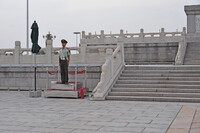| dc.coverage.spatial | Site: Beijing, Beijing Shi (municipality), China | en_US |
| dc.coverage.temporal | 1952-1958 (creation) | en_US |
| dc.creator | Sicheng, Liang | en_US |
| dc.creator | Lin, Hui-yin | en_US |
| dc.date | 1952-1958 | en_US |
| dc.date.accessioned | 2013-12-23T15:58:50Z | |
| dc.date.available | 2013-12-23T15:58:50Z | |
| dc.date.issued | 1952-1958 | en_US |
| dc.identifier | 242623 | en_US |
| dc.identifier.other | archrefid: 2898 | en_US |
| dc.identifier.uri | http://hdl.handle.net/1721.3/151151 | |
| dc.description | Military honor guard at the base; A ten-story obelisk (stele) that was erected as a national monument of the People's Republic of China to the martyrs of revolutionary struggle during the 19th and 20th centuries. It is located in the southern edge of Tiananmen Square, to the north of Mausoleum of Mao Zedong. Commissioned by the government in 1949, it was completed in 1958. The architect of the monument was Liang Sicheng, with some elements designed by his wife, Lin Huiyin (an architect and the aunt of Maya Lin). The monument has also served as the center of large-scale mourning activities that later developed into protest and unrest, such as the deaths of Premier Zhou Enlai (which developed into the Tiananmen Square protests of 1976) and Hu Yaobang (which developed into the Tiananmen Square protests of 1989). The monument covers an area of 32,000 square feet. Source: Wikipedia; http://en.wikipedia.org/wiki/Main_Page (accessed 4/26/2013) | en_US |
| dc.format.medium | marble; granite | en_US |
| dc.rights | © Scott Gilchrist, Archivision, Inc. | en_US |
| dc.subject | architecture | en_US |
| dc.subject | historical | en_US |
| dc.subject | military or war | en_US |
| dc.subject | rulers and leaders | en_US |
| dc.subject | typography or calligraphy | en_US |
| dc.subject | China--History--Opium War, 1840-1842 | en_US |
| dc.subject | Revolutionaries | en_US |
| dc.subject | Chinese Communism | en_US |
| dc.subject | Twentieth century | en_US |
| dc.subject | Socialist Realist | en_US |
| dc.title | Tiananmen Square: Monument to the People's Heroes | en_US |
| dc.title.alternative | Rénmín Yīngxióng Jìniànbēi | en_US |
| dc.title.alternative | Monument to the People's Heroes | en_US |
| dc.title.alternative | 人民英雄纪念碑 | en_US |
| dc.type | image | en_US |
| dc.rights.access | Licensed for educational and research use by the MIT community only | en_US |
| dc.identifier.vendorcode | 1A2-CH-B-FC-TS-A23 | en_US |
| vra.culturalContext | Chinese | en_US |
| vra.technique | construction (assembling), carving (processes) | en_US |
| vra.worktype | obelisk (monumental pillar) | en_US |
| vra.worktype | memorial column | en_US |
| vra.worktype | bas-relief (sculpture) | en_US |
| dc.contributor.display | Hui-yin Lin (Chinese architect, 1904-1955); Liang Sicheng (Chinese architect, 1901-1972) | en_US |


